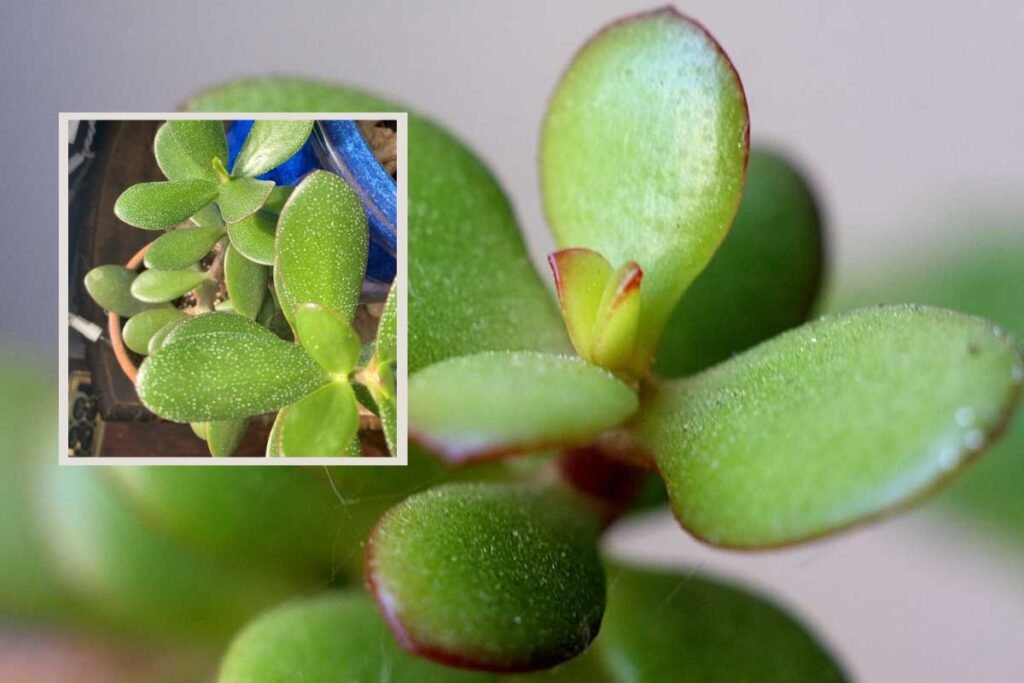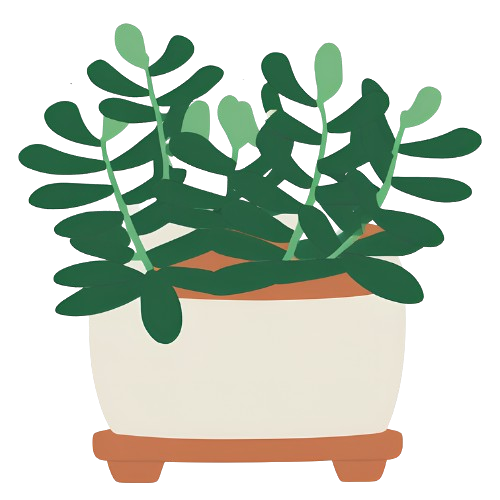Have you noticed white spots on your jade plant? Don’t worry! This common issue happens to many plant owners. Let’s look at what causes these spots and how to fix them.
Jade plants (Crassula ovata) are loved for their thick, glossy leaves. These easy-to-grow succulents can live for many years. But they sometimes get white spots that may worry you.
In this post, I’ll walk you through all you need to know about white spots on jade plants. You’ll learn what causes them, how to treat them, and simple ways to keep your plant healthy.
Table of Contents
What Are Those White Spots?

White spots on jade plants can mean different things. Let’s look at the main causes:
Powdery Mildew
Powdery mildew is a fungus that looks like white powder on leaves. It starts as small dots that grow larger. This fungus loves warm, humid places with poor air flow.
The white powder is made up of tiny fungal spores. These spores can spread to other plants if not treated. Powdery mildew won’t kill your plant right away, but it can harm growth over time.
Signs of powdery mildew include:
- White, powdery spots on leaves
- Spots that can be wiped off
- Spots that spread to more leaves
- Slight yellowing around the spots
Mineral Deposits
Jade plants can get white spots from hard water. Hard water has lots of minerals like calcium and salt. When you water your plant, these minerals stay on the leaves after the water dries.
Over time, these minerals build up and form white, crusty spots. Unlike powdery mildew, these spots won’t wipe off easily. They look more like small white scales on the leaf surface.
Mineral spots are most common on older leaves. You might notice them more near the leaf tips or edges. These spots won’t harm your plant but don’t look nice.
Mealybugs
Mealybugs are tiny white bugs that look like cotton bits. They often hide in leaf joints or under leaves. These pests suck sap from your plant, which can weaken it.
Signs of mealybugs include:
- White, cotton-like spots that move
- Sticky areas on or under leaves
- Yellowing or wilting leaves
- Black sooty mold growing on the sticky substance
Mealybugs can spread fast, so act quickly if you see them!
Scale Insects
Scale insects are small pests that attach to plants and don’t move much. They have a waxy white or tan covering that looks like tiny bumps.
Like mealybugs, scales suck plant sap. They often hang out on stems and leaf joints. Scales are harder to spot than mealybugs but can do just as much harm.
Signs of scale insects include:
- Hard, white or tan bumps that don’t move
- Sticky leaf surfaces
- Yellowing leaves
- Slow plant growth
Edema
Edema happens when a plant takes up more water than it can use. This causes cells to burst and form white or brown spots. For jade plants, this often happens with too much water or big shifts in watering.
Edema spots look like small bumps that may turn rusty brown over time. They often show up on the bottom sides of leaves. Unlike pest or fungus spots, edema spots are part of the leaf tissue.
Sunburn
Yes, plants can get sunburned too! Jade plants love light but can burn if moved too quickly into direct sun. Sunburn looks like white or brown patches, often on the sun-facing sides of leaves.
Sunburned spots may start as small white areas that turn brown or black. These spots won’t go away, as the tissue is damaged. But your plant can grow new, healthy leaves with the right care.
How to Identify the Cause of White Spots
To treat white spots, first find out what’s causing them. Here’s how to tell the difference:
- Try the wipe test: Gently wipe a spot with a damp cloth or cotton swab.
- If it wipes off easily, it’s likely powdery mildew
- If it moves or looks like tiny bugs, it’s mealybugs
- If it’s hard and doesn’t wipe off, it could be scale or mineral deposits
- Check location: Where are the spots?
- All over leaves: Likely powdery mildew or sunburn
- Mostly on older leaves: Possibly mineral deposits
- In leaf joints or stems: Likely mealybugs or scale
- On leaf undersides: Possibly edema
- Look at leaf health: Are leaves otherwise healthy?
- Yellow or wilting: Might be pests
- Otherwise normal: Could be mineral deposits
- Swollen or bumpy: Likely edema
- Think about recent changes: Have you:
- Changed watering habits? Could be edema
- Moved the plant to a sunnier spot? Might be sunburn
- Brought in new plants? Could be pests or fungus
Treating White Spots on Jade Plants
Now that you know what’s causing those white spots, let’s look at how to treat each issue:
Treating Powdery Mildew
Powdery mildew is one of the easier problems to fix. Here’s what to do:
- Isolate the plant to stop the fungus from spreading to other plants.
- Improve air flow around your jade plant. Move it to a less crowded area.
- Make a simple spray:
- Mix 1 tablespoon of baking soda with 1 gallon of water
- Add a few drops of dish soap to help the mix stick to leaves
- Spray all parts of the plant, top and bottom of leaves
- Try milk spray (yes, milk!):
- Mix 1 part milk with 9 parts water
- Spray on all leaf surfaces
- The proteins in milk help fight the fungus
- Use neem oil:
- Mix as directed on the product
- Apply to all plant parts once a week
- Neem oil works well on many plant issues
Treat weekly until the spots are gone, then every two weeks for a while to stop them from coming back.
Removing Mineral Deposits
Mineral spots won’t harm your plant but don’t look nice. Here’s how to get rid of them:
- Wipe leaves with a soft cloth dipped in distilled water or rainwater.
- For stubborn spots:
- Mix equal parts water and white vinegar
- Dip a soft cloth in this mix
- Gently wipe the spots
- Rinse with clean water after
- Change your watering method:
- Use distilled water, rainwater, or filtered water
- Water at the soil level, not on leaves
- Let tap water sit out for 24 hours before using it
Regular leaf cleaning helps stop new mineral spots from forming.
Getting Rid of Mealybugs
Mealybugs need quick action. Here’s how to deal with them:
- Isolate your plant right away to protect other plants.
- Remove bugs by hand:
- Dip a cotton swab in rubbing alcohol
- Touch each bug with the swab
- They will turn brown and die on contact
- Keep checking for a few days to catch any you missed
- Spray with insecticidal soap:
- Buy a ready-made product or make your own
- To make your own, mix 1 teaspoon mild dish soap with 1 quart of water
- Spray all parts of the plant, focusing on hiding spots
- Repeat every 5-7 days for 3-4 weeks
- Apply neem oil:
- Mix as directed on the product
- Apply to all plant parts
- Neem oil kills bugs and stops eggs from hatching
- In bad cases, you may need a stronger insecticide made for houseplants. Follow product directions carefully.
Check your plant often after treatment. Mealybugs can hide and come back if not fully removed.
Dealing with Scale Insects
Scale insects can be tough to remove. Here’s what works:
- Manual removal:
- Gently scrape scales off with a soft toothbrush or your fingernail
- Be careful not to harm the plant
- Alcohol treatment:
- Dip a cotton swab in rubbing alcohol
- Apply directly to the scales
- The alcohol breaks down their waxy cover
- Insecticidal soap:
- Apply as directed for mealybugs
- You may need more treatments as scales have good protection
- Neem oil treatment:
- Apply as directed above
- Repeat weekly for at least 3-4 weeks
- Prune heavily infested parts if the problem is bad in certain areas.
Scale insects can be stubborn. Keep checking and treating until all signs are gone.
Fixing Edema
Since edema comes from watering issues, the fix is simple:
- Let the soil dry out between waterings.
- Check your pot drainage – make sure water can flow out freely.
- Water in the morning so excess moisture can dry during the day.
- Keep temperature steady – avoid big temperature swings.
The good news: new spots won’t form with better watering. Old spots won’t go away but new growth will be healthy.
Healing Sunburn
Sunburned spots won’t heal, but you can stop more damage:
- Move the plant to a less sunny spot right away.
- Gradually reintroduce to sun – start with morning sun only.
- Don’t prune damaged leaves unless they’re very bad – the plant still uses them for energy.
- Keep soil slightly moist while the plant recovers.
With time, new growth will replace damaged leaves.
Preventing White Spots on Jade Plants

The best way to deal with white spots is to stop them before they start. Here’s how:
Proper Watering
Good watering habits prevent many jade plant problems:
- Let soil dry out between waterings. Stick your finger 1-2 inches into the soil – if it’s dry, it’s time to water.
- Water deeply but rarely. Jade plants are succulents that store water in their leaves.
- Avoid wetting the leaves when watering. Water at soil level or from the bottom.
- Use room temperature water. Cold water can shock the plant.
- Reduce watering in winter when plant growth slows down.
Right Light Conditions
Jade plants need the right amount of light:
- Give bright, indirect light for most of the day.
- Introduce to direct sun slowly if you want to put your plant in a sunny window.
- Watch for signs of too much light – leaves turning red at the edges is normal, but white or brown patches mean sunburn.
- Rotate your plant so all sides get even light.
Good Air Flow
Proper air circulation helps prevent fungal issues:
- Don’t crowd plants together – give each one space.
- Use a small fan on low setting if your room has poor air flow.
- Open windows occasionally when weather permits.
- Avoid placing jade plants in bathrooms or other high-humidity areas.
Regular Cleaning
Clean plants are healthy plants:
- Dust leaves gently with a soft cloth every few weeks.
- Inspect regularly for early signs of pests or disease.
- Clean tools before using on different plants to avoid spreading problems.
Proper Soil and Potting
The right growing conditions make a big difference:
- Use well-draining succulent soil. Mix regular potting soil with perlite or sand if needed.
- Make sure pots have drainage holes to prevent root rot.
- Don’t use too large a pot – jade plants do better slightly root-bound.
- Repot every 2-3 years with fresh soil.
My Experience with This Problem
I’ve grown jade plants for years, and I’ve seen most of these issues firsthand. My first jade plant got powdery mildew after I moved it to a humid bathroom. I didn’t know what it was at first, and it spread to several leaves before I took action.
I tried the milk spray method and was skeptical, but it worked well! The spots were gone after two treatments, and I learned to keep my jade in a drier room with better air flow.
Later, I noticed crusty white spots on an older jade plant. I thought it was mildew again, but these spots wouldn’t wipe off. After some research, I realized they were mineral deposits from my hard tap water. I started using filtered water, and the new growth came in clean and glossy.
The toughest problem I faced was mealybugs that came in on a new plant. They spread to my jade before I noticed. It took weeks of consistent treatment with alcohol swabs and neem oil to get rid of them. Now I always quarantine new plants for two weeks before putting them near my others.
Special Care Tips for Jade Plants
Beyond white spot prevention, here are some tips to help your jade plant thrive:
Seasonal Care Changes
Jade plants need different care through the year:
- Spring and summer: This is the growing season. Water when soil is dry and feed monthly with diluted succulent fertilizer.
- Fall: Start cutting back on water and stop fertilizing to prepare the plant for winter rest.
- Winter: Water sparingly – just enough to prevent shriveling. Don’t fertilize. Keep away from cold drafts.
Pruning for Health and Shape
Proper pruning helps jade plants stay healthy:
- Remove dead or damaged leaves whenever you see them.
- Pinch growing tips to encourage branching and bushier growth.
- Prune in spring before the growing season starts.
- Use clean, sharp scissors or pruning shears to avoid tearing the plant tissue.
Propagation from Healthy Plants
Healthy jade plants are easy to propagate:
- Take leaf or stem cuttings from parts with no white spots or other issues.
- Let cuttings dry for 2-3 days until the cut end forms a callus.
- Plant in slightly moist succulent soil or lay leaves on top of soil.
- Wait patiently – roots may take 2-4 weeks to form.
When to Repot a Jade Plant with White Spots
Should you repot a jade plant with white spots? It depends:
- For powdery mildew: No need to repot, just treat the plant.
- For mineral deposits: No need to repot, but consider changing your water source.
- For pests: If the infestation is bad, repotting with fresh soil can help remove eggs or bugs in the soil. Wash the roots gently and inspect them for pests.
- For edema: If soil isn’t draining well, repotting with better draining mix can help.
When repotting:
- Use fresh, well-draining succulent soil
- Choose a pot just 1-2 inches larger than the current one
- Make sure the new pot has drainage holes
- Wait a few days before watering after repotting
Common Questions About White Spots on Jade Plants
Are white spots harmful to jade plants?
Some white spots, like mineral deposits, are just cosmetic issues. Others, like pests or fungus, can harm your plant if not treated. Check which type you have to know how concerned to be.
Can white spots spread to other plants?
Powdery mildew and pests like mealybugs and scale can definitely spread to other plants. Isolate affected plants right away and check nearby plants often.
How often should I check my jade plant for white spots?
Check your jade plant at least once a week. Look at both sides of leaves, stems, and leaf joints where pests often hide. Early detection means easier treatment.
Can jade plants recover from white spots?
Yes! Jade plants are tough. With the right treatment, your plant can fully recover from most causes of white spots. Damaged leaves might not look perfect again, but new growth will be healthy.
Will cut leaves with white spots grow new plants?
It’s best not to propagate from affected leaves or stems. Wait until your plant is healthy, then take cuttings from clean, spot-free areas.
Final Thoughts
White spots on jade plants are common but usually fixable. The key is to find out what’s causing the spots and take the right steps to fix the problem.
Remember that prevention is easier than treatment. Good plant care habits like proper watering, the right light, and regular checking will keep your jade plant healthy and spot-free.
Don’t worry if you see white spots – your plant isn’t doomed! With a bit of care and the tips in this guide, your jade plant can get back to its glossy, green beauty in no time.
Have you dealt with white spots on your jade plant? What worked for you? Share your story in the comments below!

My name is Shahriar Robin, and I’m the creator of JadePlants.org. Growing up in a village, I developed a deep connection with nature from a young age. Plants and gardening have always been a part of my life, and jade plants, with their resilience and elegance, have held a special place in my heart. Over the years, I’ve learned so much about these fascinating plants, and I created this site to share that knowledge with you—completely free of charge.

